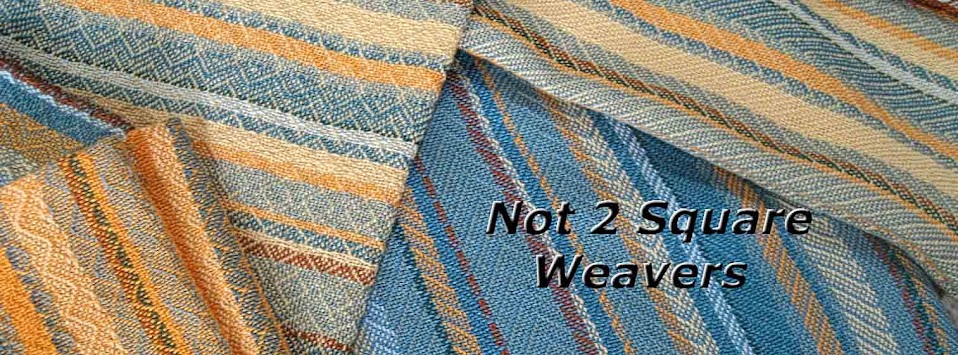Dee is ever the adventurer. She purchased a set of dyes called Alter Ego Dyes from Dharma Trading Company. This product allows you to dye two different colors in the same bath. One dye affixes itself to protein fibers and the other to cellulose fibers. The original use of these dyes was to dye velvet devore fabrics where the backing is usually silk and the velvet is rayon. However, it seems like there may be other possibilities for handweavers and Dee was the first in our group to bite the bullet and put down hard cash for a sample set.
In this first photo, the scarves were both woven on the same warp and were all white. After dying you can pick out that the blue and red are Merino and the shiny rayon is copper in the blue scarf and purple in the red one. How cool to be able to put on one long warp, weave several items and then dye them in a variety of color combinations (think Henry's Attic yarns).
 This next set of two scarves are rayon and silk and also woven on the same warp in the same weave structure. Notice how the pattern has almost entirely disappeared from the blue scarf, but shows up nicely in the red/orange scarf. Dee says the scarves were neon bright after dyeing, so she toned them down in a Lanaset dye bath, which affected the silk only.
This next set of two scarves are rayon and silk and also woven on the same warp in the same weave structure. Notice how the pattern has almost entirely disappeared from the blue scarf, but shows up nicely in the red/orange scarf. Dee says the scarves were neon bright after dyeing, so she toned them down in a Lanaset dye bath, which affected the silk only. If you have followed the link to the Dharma site, you will see that these dyes are pricey and I'm thinking that this is mostly a matter of having fun experimenting with something new. But as was discussed in the meeting, you could try a variety of fibers - silk, wool, rayon, cotton, bamboo, soy silk in the same piece. Each of the fibers would take up the dye a bit differently and the reflective qualities of the yarns are different so your finished piece might be very complex in appearance. There is obviously a lot of room for experimentation here. Dee says the dyes were easy to use and do require heat setting.
Dee's other contribution to the show and tell was a lovely brick colored shawl. The multicolor thread that
runs through the piece in warp and weft is broken up by the brick colored rayon. Dee started weaving the shawl with every pick being the multicolor rayon, but soon decided that it was too much. So she left what she had done (afterall the hem stitching was already done on that end) and started using it every third pick, alternating with the brick rayon in the warp. At the other end of the shawl, she repeated the pattern started at the beginning so there is a nice little design touch in what might have seemed like a troubled beginning.










